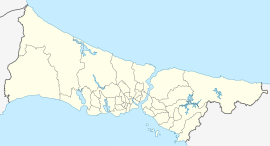Arnavutköy (lit. 'Albanian village';[1][2] Greek: Μέγα Ρεύμα, romanized: Mega Revma) is a neighbourhood in the municipality and district of Beşiktaş, Istanbul Province, Turkey.[3] Its population is 3,574 (2022).[4] It is renowned for its wooden Ottoman mansions and seafood restaurants, as well as for the campus of the prestigious Robert College with its historic buildings. It is part of the Beşiktaş district of Istanbul, and is located between Ortaköy and Bebek on the European shoreline of the Bosphorus strait.
The existence of a mosque, church and synagogue in close proximity to one another serves as a reminder of Arnavutköy's past cosmopolitanism.
The coast road is usually lined with anglers and small fishing boats frequently pass Arnavutköy; the fresh fish caught is sometimes sold to the local seafood restaurants. At the eastern end of Arnavutköy the coast juts out to form Akıntıburnu (the Cape of the Current) where the waters of the Bosphorus once flowed so powerfully that small boats had to be towed round it.[5]
Infrequent Şehir Hatları (City Lines) ferries call in at the ferry terminal facing Arnavutköy's main square. Otherwise, the busy coast road is served by regular buses.
YouTube Encyclopedic
-
1/5Views:51 58417 36142 0938 8678 340
-
Istanbul Arnavutköy| Walking Tour In A Luxurious And Old Neighborhood 11July 2021|4k UHD 60fps|
-
Arnavutköy and Bebek | Exploring two neighborhoods by the Bosphorus in Istanbul, Turkey.
-
İstanbul Arnavutköy Yalıları ve Rumeli Yakası Sokaklarında Yürüyüş | İstanbul Nisan 2020 | 4K 60 FPS
-
Istanbul Arnavutköy Neighbourhood Walking Tour 2 November 2021|4k UHD 60fps
-
Arnavutköy area, Istanbul - منطقة ارنافوتكوي- اسطنبول- تركيا
Transcription
History

In antiquity, the area was known as Asomato and Anáplus. In 1468, Sultan Mehmed the Conqueror brought Albanians to the city for pavement construction. He installed them in Arnavutköy, hence the name of the suburb.[1][6][2]
In 1863, Robert College, the oldest American school outside the United States, was established on its current campus which originally stretched from Arnavutköy to the vicinity of Bebek and Rumelihisarı. In 1971, a section of this campus became part of Boğaziçi University, which was formerly the college section of the school. The high school section, formerly named Robert Academy (RA) is still an American school and is located on the Arnavutköy side of the Robert College campus.
According to the Salname for 1912, the district's total population was 7,482, consisting ethnographically of 5,973 Rûms (Christians), 493 Muslims, 342 Armenians, 32 Jews and 642 people of other nationality.[7][8]
Arnavutköy used to be famous for its Ottoman strawberries, a less juicy and smaller version of the strawberries found throughout the rest of Turkey. A few strawberry fields still survive inland from the coast and every spring local greengrocers are mobbed by strawberry lovers.
Architecture
The waterfront at Arnavutköy is lined with some of the most picturesque late 19th and early 20th-century wooden houses to survive along the Bosphorus, many of them decorated in Art Nouveau style.[9] While they look very individual, it is thought that most of the decorative elements on the facades were actually mass-produced.
Education
The American Academy for Girls moved to Arnavutköy in 1914, but in 1923 moved to the Bağlarbaşı neighbourhood of Üsküdar on the Asian side of the city where it continues to accept students as the Üsküdar American Academy.
See also
Gallery
References
- ^ a b Kreiser, Klaus (2009). Istanbul: ein historischer Stadtführer. Verlag CH Beck. p. 20. ISBN 9783406590634. "Europäische Migranten sind verantwortlich für Ortsnamen wie Arnavutköy («Albanerdorf»)"
- ^ a b Coşkun, Burhanettin; Yolcu, Tuğba (28–29 April 2016). "Küreselleşen dünyada göç sorunları ve Türkiye'nin bölgesel rolü [Migration issues in the globalizing world and Turkey's regional role]". Aralik University: 97. Retrieved 12 June 2019.
{{cite journal}}: Cite journal requires|journal=(help) "İlk defa Türkiye'ye Fatih Sultan Mehmet zamanında getirilen Arnavutlar, 1468 senesinde İstanbul’un Arnavutköy semtine yerleştirilmişlerdir. Arnavutköy, 1468 yılında Arnavut göçmenler tarafından oluşturulmuştur. Kültürümüzün temel taşlarından olan semtlere (Arnavutköy, Arnavutkaldırımı)" - ^ Mahalle, Turkey Civil Administration Departments Inventory. Retrieved 12 July 2023.
- ^ "Address-based population registration system (ADNKS) results dated 31 December 2022, Favorite Reports" (XLS). TÜİK. Retrieved 12 July 2023.
- ^ 1 Yale 1 Tonguç, 1 Pat 2 Saffet Emre (2010). Istanbul The Ultimate Guide (1st ed.). Istanbul: Boyut. p. 423. ISBN 9789752307346.
{{cite book}}: CS1 maint: numeric names: authors list (link) - ^ Çebi, Emrin (2017). "The role of Turkish NGOs in social cohesion of Syrians". Turkish Journal of Middle Eastern Studies (Special Issue-1 Middle East and Migration): 87–107. doi:10.26513/tocd.312245. "Some examples of prominent migrations such as migration of Albanians who were placed in Arnavutköy in 1468"
- ^ Reşat Ekrem Koçu, İstanbul Ansiklopedisi, vol. 2 (İstanbul 1958-1971), p. 1.041
- ^ Papastratis Th., Γειτονιές του Βοσπόρου [Neighborhoods of Bosporus], Athens, 2003, p. 72
- ^ 1 Barillari 2 Godoli, 1 Diana 2 Ezio (1996). Istanbul 1900: Art Nouveau Architecture and Interiors (1st ed.). New York: Rizzoli International Publications. pp. 201–04. ISBN 0847819892.
{{cite book}}: CS1 maint: numeric names: authors list (link)











